How are you? Have you eaten?
- Cristina Dwyer

- Jul 18, 2023
- 16 min read
Updated: Jun 5, 2024
One of the first Korean words that I heard and learned is “Annyeonghaseyo” (안녕하세요) which translates to a polite “hello”. I didn’t get to learn the more casual “Hi, how are you?” until I had a Korean language lesson dedicated to … food. “Bap meogeosseoyo?”(밥 먹었어요 ) is commonly used among family members and close friends, and it literally translates to “Have you eaten?”. At first, I was puzzled, wondering why food is part of a daily greeting and what a polite answer would even be to this kind of question. The expression seems to have originated during post-war times of hardship when food was scarce. Although times have changed, the expression has endured. Perhaps because the language of food is ultimately a language of caring, and sharing a meal is about more than just being fed—it's about having a good time and being in good company. And, as I learned in the day-to-day life lessons, when you cook, share, and eat the Korean way, there’s lots of food and lots of caring!
I had my very first traditional Korean meal in Chuncheon at a lunch organized by Eddie’s colleagues last year. It was my first time in Korea and I confess I was overwhelmed by the unfamiliar language and new places, so I cannot recall the name of the restaurant. However, I do remember that it was highly regarded for its authentic and elaborate Korean traditional menu. I was expecting a special meal, but nothing could have prepared me for the royal feast that awaited me. As we sat in a separate room, chatting and eagerly awaiting our meal, something truly unique unfolded before us.
Two ladies appeared, wheeling a cart with a tabletop filled with bowls and plates.
Quickly and precisely, they aligned the tabletop with our table and effortlessly slid it on top of the table.
Then, another cart arrived with yet another tabletop, and voila, our table was completely set.
Among the 19 different types of dishes that I could count there was something for everyone’s taste: beef, fish, seafood, sophisticated vegetable dishes, rice in traditional hot stone pots. Describing each dish in detail would be futile, so I will leave it to the photos as they would do a better job than me. What the pictures may not fully relate is the vivid memory I still have of the aromas, taste and the warm welcome I felt while we were sharing this meal.
More recently, my Korean friend Stacey took me to Sanchaehyang (산채향) in Seoul for a Friday lunch. I was delighted to discover that even a more casual traditional Korean meal can fill up a table with dishes. The small restaurant in the Jongno district was busy as office workers were out for lunch, so we had to wait a bit to get the outside table we had eyed upon our arrival.
Although the menu was set, we could choose the main meat and, for us, it was a beef patty and eel. The eel, cooked in a sweet soy sauce, was served on a bed of lettuce with grated radishes that perfectly complemented its slightly fatty texture. The well-seasoned beef patty, cooked well done, came with a slightly sweet sauce. We savored nine side dishes, including the tender beef bulgogi (grilled marinated beef), served on a bed of lettuce.

One refreshing dish stood out for me: a finely grated radish on black sesame thick sauce, with a sweet and tangy flavor. We enjoyed a steamed mix of brown and white rice cooked with daedok, accompanied by a soy-based chopped scallion vinaigrette on the side, to be mixed in. Our meal also featured a light seaweed soup, a radish salad with a mayo-based dressing, slightly sweet and spicy, garnished with herbs, and a bean sprouts salad.
As we savored each bite, we chatted and laughed, enjoying this quiet spot in the shade. The time spent together, sharing this delicious Korean meal, made the experience even more memorable.
While in Canada, I had heard of Korean barbecue and kimchi, but I hadn't tried either of them. I naturally lean towards a vegetarian-pescatarian diet and I’m not too keen on spicy flavors, so there was simply no natural attraction. However, Eddie, my husband, who likes his meat and has travelled extensively in Korea, insisted that I try Korean barbecue. He launched an unwavering campaign to persuade me, most likely to ensure I wouldn't be an obstacle to him reaching out to his favourite meal. And he succeeded. Not only did I try it once, but I ended up loving it.
Korean barbecue is about grilling meats like beef, pork, or chicken. Charcoal grills are often built into the table, while the gas grills are typically portable, placed onto the table. A fan, positioned on top of the grill, helps absorb the smoke and heat. At times, the grilling would extend to vegetables like onions, mushrooms, sweet potatoes, zucchini, or eggplant.
Alongside the meat, a minimum of three mini side dishes are always served, such as classic napa cabbage kimchi, garlic, coarse salt, ground hot red pepper, spicy sauces like gochujang, or mild jalapeno pepper salad.
Then, there are the side dishes which, in all honesty, are my favourite part. They do set the tone for the meal with their variety and sophistication. Most of them are vegetable-based, fresh or marinated, usually served at room temperature on individual plates. Warm dishes like steamed rice or soups may also be part of the menu. Like in the traditional Korean meal, all these dishes are meant to be shared, so the quantity on each plate depends on the number of diners. I’ve had the chance of tasting quite a few dishes so far, including different radish varieties, green beans with garlic and spicy sauce, bean sprouts with onions and bell peppers, green onion salad, a wide range of kimchi, spicy jalapeno pepper salad, sweet potatoes mashed or deep-fried, glass noodles, neatly shaped egg omelets, seasoned tofu, and refreshing lettuce, cucumber, or tomato salads.

Another rather interesting component of the Korean barbecue is a stack of leaves, the most common being lettuce and perilla (new for me and surprisingly delicious with their tangy taste and soft texture). What are they for? Well, a typical way to eat the Korean barbecue is to wrap the meat in these leaves, along with a sauce or maybe a spoonful of a side dish, and have it all as a mouthful. Yes, it must be a mouthful, or else you will risk having a non-glamorous drip along your face, and I am speaking from experience.
While the side dishes are prepared in advance, the meat is cooked right at the table, by the staff or diners. The meat is brought in small to medium portions, usually too big to be handled with chopsticks. Grilling is a gradual process—first, the meat is lightly grilled on all sides in its initial size.
Then, it's cut into slices using special kitchen scissors, and the raw sides are grilled next. Finally, the meat turns juicy inside with a nicely grilled facade, cut into bite-sized pieces. Once cooked, the meat is set aside on the grill to keep warm, and everyone serves themselves from there.
All right, so we have a few delicious side dishes and some grilled meat, what is so special, taste-wise, about the Korean barbecue? The answer is “The meat, and it's mostly the beef!”
Many people are familiar with or at least heard of wagyu and Kobe, the premium Japanese beef varieties. How about Hanwoo beef? I would be ready to bet that very few non-Koreans heard of, and even fewer tasted it outside South Korea. Hanwoo, one of the oldest cattle breeds globally, is indigenous to Korea. These cattle are locally raised on a diet of grass and mixed grains, resulting in marbled, slightly sweet, and beefy-flavored meat. Less fatty than wagyu, the grilled Hanwoo beef melts in your mouth, but still has the flavour and texture of a lean meat. I always had the Hanwoo beef grilled raw, without any marinade. When done, it only needs a dip in coarse salt and maybe a touch of the spicy powder, to fully appreciate its natural flavour.
Coveted and pricey, I was surprised to find Hanwoo beef available even in casual restaurants. While it is considered a treat, people enjoy it as a regular meal as well, and we were no exception. One evening we decided to try Udeharu (우대하루) a small restaurant in our neighbourhood, that always appeared busy when we passed by. On that evening we lucked out and got a table without reservation. It is a mid-range restaurant with a casual atmosphere, offering a high-quality menu and excellent service. The price tag for a Hanwoo menu at this restaurant was about 100,000 -150, 000 ₩ (about 100-150 CDN$) per person. It is indeed on the higher end for a casual dinner, just like my recommendation to try it at least once.
In my experience, unmarinated beef is preferred for a dine-in barbecue and is a must when having Hanwoo. Marinated beef, equally popular and delicious, is being used to prepare “bulgogi” (불고기), “fire meat”, which comes as thin strips of meat, and “galbi” (갈비), short ribs. They are both a staple in Korean cuisine, served fully prepared and ready to eat, either as standalone dishes or as part of a traditional Korean menu.
My introduction to the Korean barbecue was made by the famous Chuncheon Chicken Dakgalbi (닭갈비), right in Chuncheon, its birthplace! The name of the dish literally translates as “chicken ribs”. I am sure your eyebrows are raising as you read this, but despite its name, the chickens in Korea don’t have ribs. It seems that in the post-war '60s, chicken became a substitute for the pricier beef or pork ribs. There are different stories around the origin of this dish and name, and I can only assume that nobody wanted to let go of the idea of eating ribs, so they adapted while keeping the name. The secret to this unique recipe lies in the gochujang-based marinade sauce. We chose the mildly spicy option, and it was perfect: it had just enough of a “kick” to warm up my taste buds but kept them sensitive enough to enjoy the different spices and charcoal grill taste of the meat. As side dishes, we had marinated radishes and onions, kimchi, pickled cucumbers, pickled jalapeno peppers, and a sesame-based jelly of sorts. It was here where I learned how to wrap the meat in the lettuce leaf and portion it so that I can have it all in one bite!
Chicken barbecue is still a go-to meal, light and affordable, and this is what we had at Gangchon Charcoal Grilled Dakgalbi, a small barbecue joint in our neighbourhood. Their chicken, lightly marinated and not too spicy, was served with garlic, lettuce and perilla leaves, along with a green dipping sauce that looked like a pesto but had a strong garlic flavour. For refills on the side dishes, there was a self-serve station in the middle of the restaurant. Unpretentious, with a very welcoming staff, dining there felt like being in the middle of an extended family kitchen where people dropped by after work to chat over dinner with family and friends. Price tag here was just 30,000 ₩ (around CDN$ 30) for a two people meal and a beer. This this casual dine-out style is quite common in Seoul and you find it mostly tucked away in the small streets of older neighbourhoods.
We experienced a similar atmosphere and warm welcome when we walked into Hanam Pork House (하남돼지집) , a pork barbecue restaurant in the Dongdaemun Market area. They served different cuts of non-marinated pork, including the pork belly, a Koreans’ favourite. We had the usual lettuce and perilla leaves, with some kimchi, green beans, garlic, and hot sauce. Coarse salt and spices were served as mini side dishes for the meat seasoning.
As we were eating, a group of cheerful, chatty older ladies entered. As they were getting seated at their table, I noticed them stowing away jackets and purses under the bench they were going to seat on. Aha, I thought, this is where I was supposed to put my jacket and purse! It keeps them safe from the smoke and is a space saver too! One more tip to learn from the locals!
It’s interesting and good to know that casual Korean barbecue restaurants specialize in serving only one type of meat. The restaurant name or the advertising signs should give enough clues about their specialty. If there’s none of that, chances are they’re all about beef!
Eating out is common in Seoul and the food abundance doesn’t stop at the restaurants’ doors, it spills onto the streets! You can find a food stand on a corner street, serving some hot snacks, or gazillions of them in a traditional food market. All markets, regardless of their specialty, have food carts or small eateries that blend in with the market area. What I found fascinating though is that there are food markets that are basically gigantic eateries and delis! While there could be some fresh veggie and fruit stands, they are not the main characters on the market stage. The traditional food markets are all about street food and, boy, they are awesome!
The Gwangjang Market (광장시장) is on top of my list of must-see-and-experience. The market itself, all covered, is setup up on what seems to be a maze of narrow back alleys. While there is an official entrance to the market, there are a couple of ways to enter and exit. The market is open every day and stays lively till late at night, but you get most of the action during the day. Vendors are lined up on both sides of the walkways, with food stands at counter level height or even lower. The street intersections morph into mini plazas with food stands placed in the middle, in a round or square shape, serving food on the outside perimeter. Occasionally you can find a bar-style table and a bench that could accommodate a handful of people. With such a limited space, it’s not uncommon to end up eating while standing or have takeaways.
It is here where I got to try “bindaetteok” (빈대떡) , the mung bean pancake. The pancake is about 10-15cm in diameter and 3/4cm thick, and is a meal on its own.

In addition to the ground mung bean paste, the batter also contains rice flour, kimchi, bean sprouts, shrimp, or pork. Delicious, labour intensive and deep fried, it is a market favourite as very few venture out to prepare it at home.
As I wondered around the market it was hard to miss the large assortment of sausages, of various shapes and colours, some rather interesting looking. They could be either bought or enjoyed on the spot. In Korean cuisines, preparing and using animal organs for meals or sausages is common. This sight may be strange for the modern city dweller, but I am used to the concept – in rural Romania, when an animal is sacrificed for food, there is little to no waste.
Of all the sausage vendors, there was one that had a good 20 m line-up. There was an elderly lady and probably her son, seated right in the middle of the walkway, on two small stools and with a low “table” improvised from plastic boxes.

They were selling fresh “sundae” (순대), bloody sausages, a very popular Korean specialty. I could not figure out what was so special about their sausage, as they looked the same to me, and the service was miles away from the white coat butcher standard. I took my puzzle to my Korean language teacher and her guess was that those sausages were homemade, not a resell from a larger meat processing plant. The lady was probably known and sought after by the regular market goers, hence the line-up.
We did not have the guts to try the bloody sausage, and went instead for dumplings at a small stand, where we could also seat down and eat. We had a choice between spicy or non-spicy, steamed, or fried, and we picked a few of each kind.
Other than the spiciness level I think the filling was about the same for all of them: vegetables, mostly likely cabbage, green onions, kimchi, and some meat, probably pork. As we were waiting, contemplating the place that was overflowing with dumplings and kimchi, I noticed that the dumplings were getting reheated rather than cooked on the spot and was a bit disappointed. However, once I started to eat, hungry after seeing so much food, I forgot all about it. The dumplings, very likely freshly done that day, were tasty, and the ladies running the stand treated us like long-time customers, so it was all good.
When done, we kept walking with renewed energy and … ran into more dumplings, at the stand of a Netflix-famous Dumpling Lady. Her station, square shaped, was centered at a street crossing. She was cooking up a storm in the middle, surrounded by customers eating or waiting online. The dumplings were quite inviting, but we were too full, so we had to pass, planning to come back and try them out.
One of the most popular street food specialties, technically considered a snack, is the Oily Spicy Rice Cake, “tteokbokki” (떡볶이). Despite its good reputation and being at every corner in the Gwangjang market, I didn’t have the courage to try it at the time.

For a start, it doesn’t resemble a cake at all! Picture a thick, fiery paprika-red soup filled with these chubby white tubes, which are the rice cakes! They’re totally vegan, made of flour from glutinous and non-glutinous rice, and possibly from other grains. There is no meat in the dish, but the sauce broth usually has a fish or seafood base. As we left the market, curious and intrigued by its popularity, I put it on my must-try-foods list.
It didn’t take long and I got to check it off at the Tongin Market (통인시장), the perfect place to sample Korean street food. The market, opened back in 1941, offers a unique consumer experience: you create your own lunch box by buying food from different stands using brass coins (“yeopjong”). With our food trays and 10,000 ₩ (CDN$ 10) worth of coins for each of us, Eddie and I ventured throughout the marked and filled up our lunch boxes with a little bit of everything: dumplings soup, fish cake soup (looks like a thin pancake, cut in rectangular strips), deep fried breaded chicken, rolled omelet, deep fried breaded shrimp, dumplings, kimchi pancake, gimbap, and the famous spicy rice cake.
The first bite of the spicy rice cake was a bit … mehhh. The sauce was sweet and spicy, the rice cake had a soft texture, neutral taste, and was a nice complement to the rich sauce. That version of the dish had fish cake, which enhanced the taste but also made it non-vegetarian. As I was going through my lunch box, I gradually found myself dipping everything in that sauce. “What is happening to me?”, I thought. I too got addicted to the “tteokbokki” which lived up to its reputation! Next I want to try the crispy version, where the rice cakes are first dipped in the sauce and then fried. One off the list, one on the list. I don’t think I will ever be able to keep up!
I didn’t expect to enjoy street food so much. While tasty, it is not the healthiest option, as a lot is deep fried. However, there is something about the atmosphere in a food market, a homey feel that both locals and foreigners tune in. The stands are usually run by middle-aged or older ladies, who have a warm way of inviting people to taste their food, like a beloved aunt or grandma. Then there is the buzz of the people moving around, the mingled aromas, and the heat from the cooking stations, which feels so good, especially in wintertime. You may be eating by yourself, but you don’t feel alone.
To experience street food right on the street, Myeongdong (명동) Walking Street is the place to go. “Open” every day till late at night and with more room to move around, Myeongdong is vibrant and attractive, with the hustle and bustle of vendors and customers. As night falls, the street gets filled up with colourful lights from the food carts and nearby stores, and it feels like a street party!
The mobile food carts tend to favour the grilled or teppanyaki style of food, like the grilled squid, cheese kimchi roll pork belly, grilled lobster tail, fried baby octopus or grilled cheese on a skewer.
Not surprisingly there are quite a few Japanese savory snacks like “takoyaki”, an octopus infused batter cooked in small ball shaped hot forms, and “okonomiyaki”, a pancake like batter cooked in round shape forms with different toppings of shrimp, cheese, veggies, and a big sunny up egg.
One of the most popular winter sweet snacks is the “bungeo-ppang” (붕어빵), a fish shaped waffle pastry filled with sweetened bean paste (original recipe), chocolate or vanilla custard cream. Not too sweet, crispy, and warm, it’s really hard to wait for it too cool down when you get it off the stand. A similar sweet treat, equally tempting and addictive, is the walnut cookie, “hodugwaja” (호두과자 ). Shaped like a walnut, the “shell” is made of wheat flour and pounded walnuts, while the filling is made of red bean paste and walnuts.
Other sweets like glazed fruit skewers or “dalgona candies” will tempt you or at least stir your curiosity.
I couldn’t resist trying these handmade candies made of very fine honey threads, pulled into a small bunch that wraps around a filling made of nuts, sesame or sweet bean. They melt in your mouth and are not too sweet, but the trick is to eat them on the spot, as soon as they are made, or else they harden and become a dentist bill.

To end it on a healthy note and not feel too guilty after a street food feast, you can have a ... bag of freshly squeezed orange or grapefruit juice
If you would rather sit down in a restaurant, there are tons near Myeondong street. When my friend Carrie was here in early March, after eyeing all the inviting street food, we decided to go eat at a restaurant.
While trying to find our way towards a lobster restaurant, we got sidetracked by this heavily decorated Michelin Guide Recommended hole-in-the-wall place called Myeongdong Kyoja ( 명동교자). We took a seat, the server came, we asked for the menu and she pointed it out to the wall. There was a choice of three dumpling soups, one being sold out, and one choice of dumplings. The decision was easy - we ordered one of each. Atypical for a restaurant, we had to pay in advance, and it came to around ₩10,000 (CDN$10) per meal.
Despite the bare minimum setup, the place had a robot waiter lending a hand. It seemed we were the only ones taking our time eating and talking, as most people were in and out in no time. No K-socializing in that place! Oh, and yes, the dumplings were delicious, generously portioned, at a price hard to beat in one of the most touristic areas in Seoul.
If you are curious to follow the food to the source, then visiting some of the fresh produce and meat markets is worth the trip. The major ones I know of in Seoul operate both as retail and wholesale markets: Cheongryangri Fruit & Vegetable Market (청량리 청과물 도매시장), Majang Meat Market (마장축 산물 도매시장) and Noryangjin Fish Market (노량진 수산물 도매시장). Ironically I haven’t made it yet to the fresh produce market, because of the far distance and cold season, but I did visit the meat and fisheries ones.
If you come to Seoul and have time to see only one fresh market in the city, I would highly recommend the Noryangjin Market. One of South Korea’s largest seafood markets, it trades some 250 to 300 tons of fishery products every day. The market hall is huge, with numerous food stands, grouped by fish or seafood categories. The variety is unimaginable and, I must confess, there were very few species that I could recognize.
With the numerous water tanks to keep it all fresh during the day, the place resembles an aquarium, with … a shorter life span for the tenants. This place is as authentic as it can be for a fisherman world, and if you want guaranteed freshness, may need to be ready to face your dinner having their last swim. Some of the vendors can prepare a platter of sashimi grade fish to take home. If you don’t feel like cooking, you can get the fish or seafood at one of the nearby restaurants and they will cook it for you.
Looking back, I am still not clear how I got to enjoy the Korean barbecue so much when I typically eat only fish or seafood. And as someone conscious about healthy eating, it's equally puzzling how street food won me over. Must be a Korean spell at work here!
What is certain is that each time I think back on the times I ate out I have a smile on my face. I remember aromas and special flavours, trying out new foods even if I didn’t know what I was about to eat. I remember Eddie and I cooking, sharing a meal with friends, telling stories, and laughing. From cozy little restaurants to the bustling streetside vendors, I'll never forget the kind strangers who looked at me with eyes that seemed to say, "Bap meogeosseoyo? How are you?" It was as if they were ready to embrace me as family.






























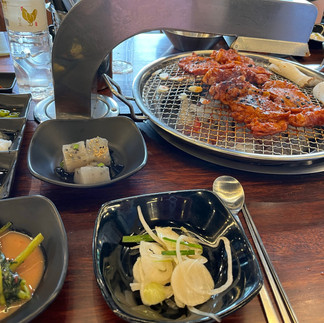









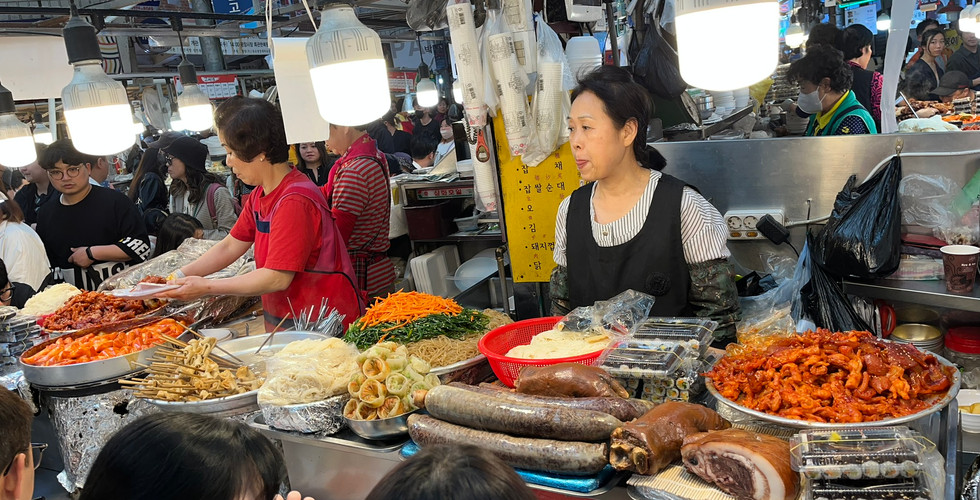





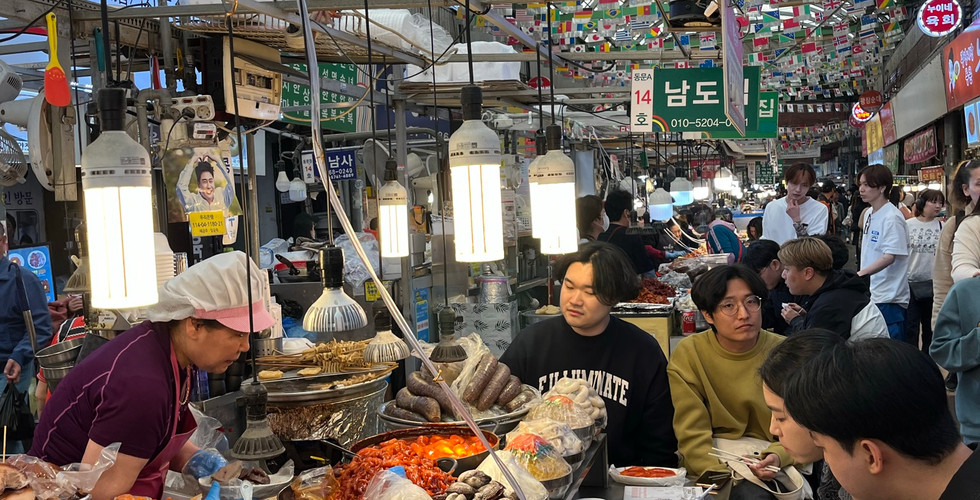









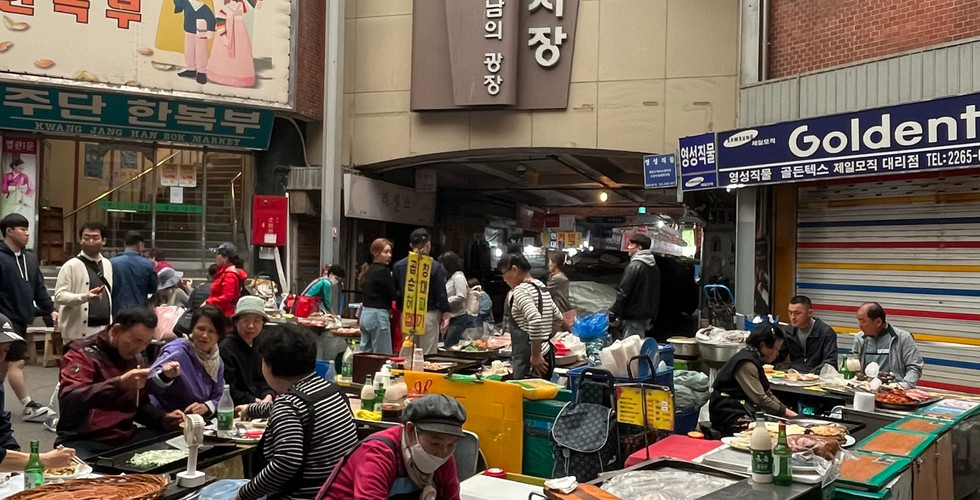

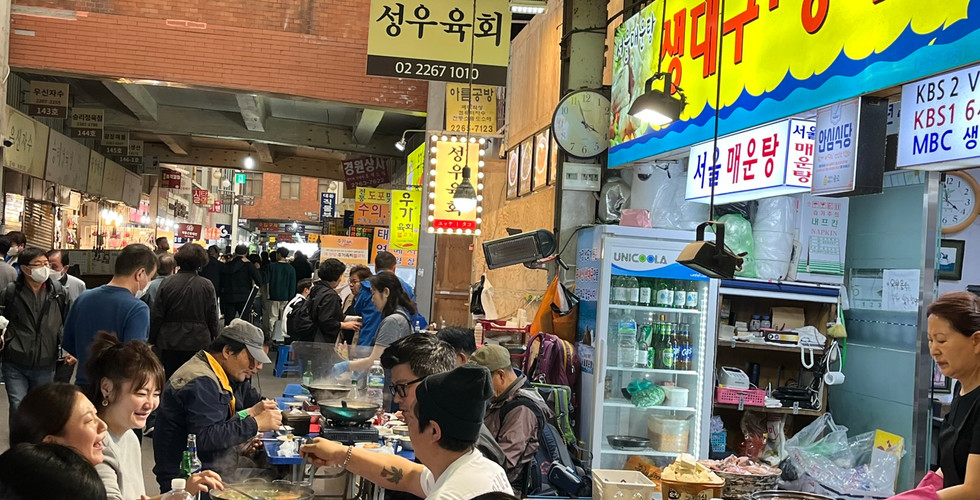















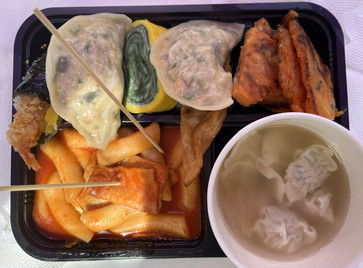













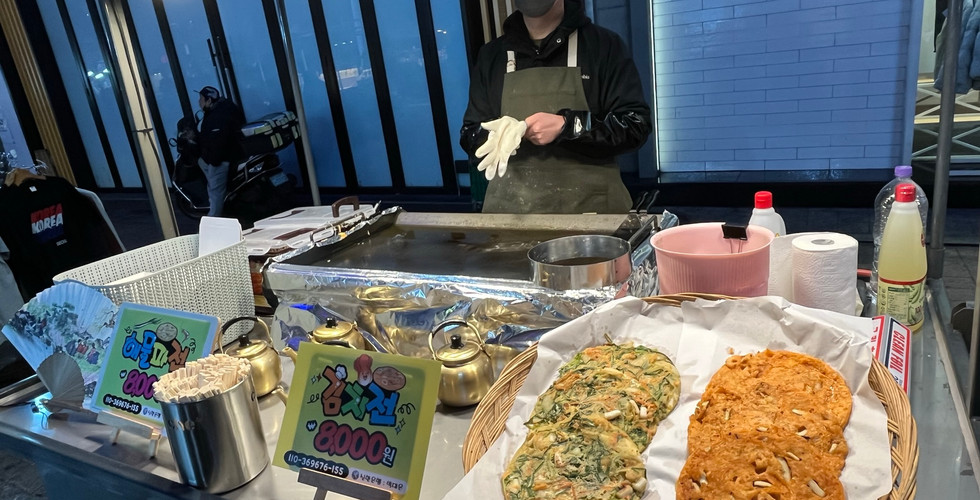











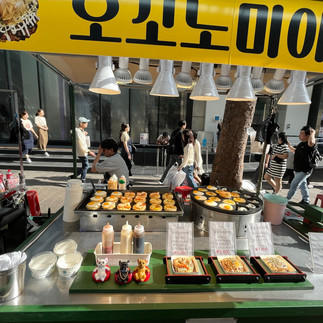





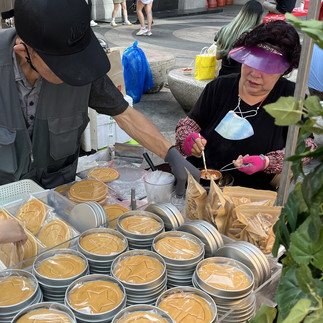



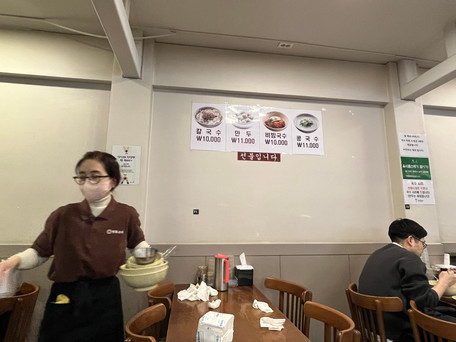

























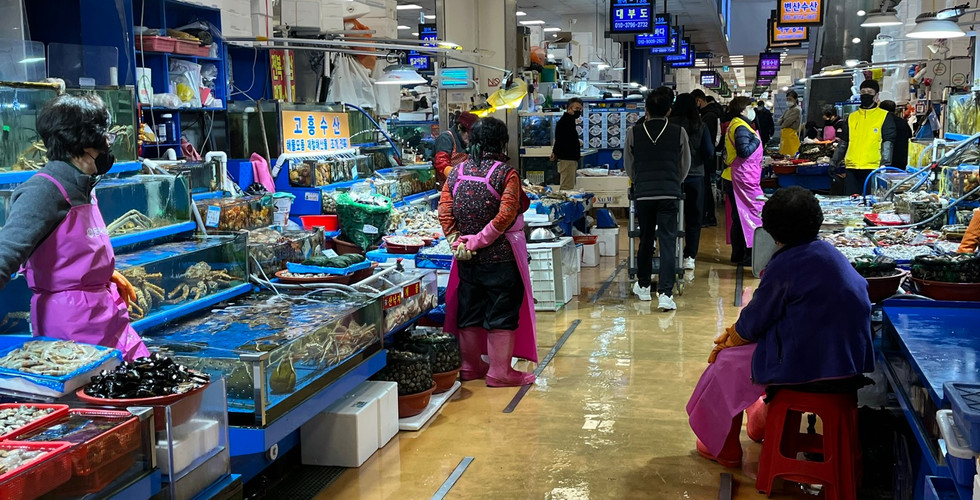

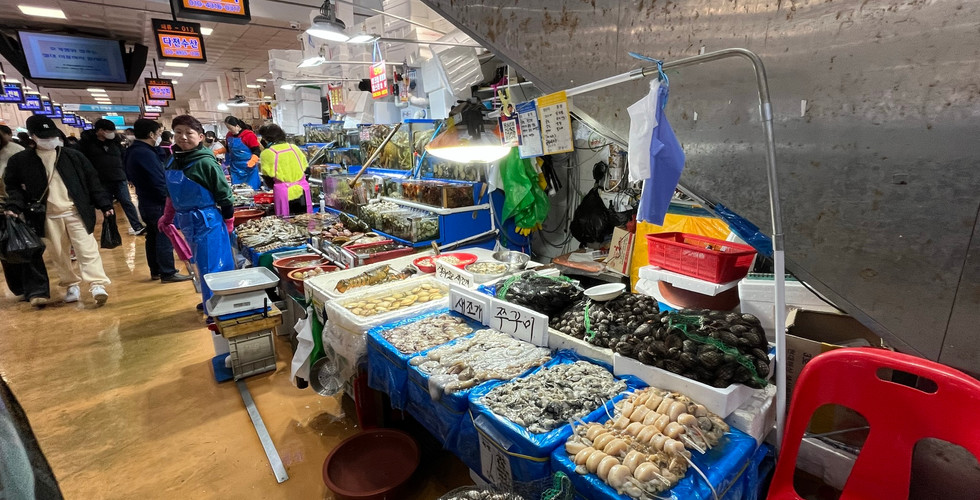




Mmm you're making me hungry!
Wow! What a wonderful experience! Thank you for sharing it with us! Lots of love, Wanda xx
Cristina, what an excellent post! You surprised me with how good of a writer you are. Did not know you had this talent.
Of course I love the subject area (Korea...food...) even if I don't eat pork or red meat. Let alone intestines.... And can't handle spicy foods. Food is a big factor in most KDramas (especially a good one I saw recently called Chocolate <romantic melodrama> that intertwined food and love.
After the Korean war the country was desolate and food was sparse so eating is not something they take for granted. A way to connect, as you show.
Now I am very interested to try some of the chicken dishes and of course the sweets! The way you…
Wow awesome post. Not sure who that fella is in some of your photos, but he is one lucky guy to be able to accompany you on this adventur.